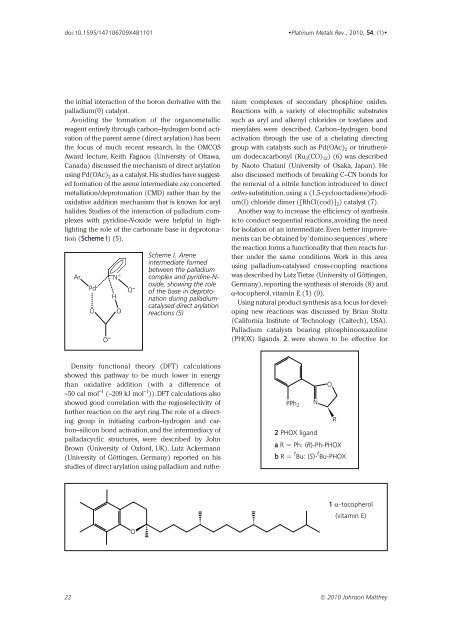Download Issue PDF - Platinum Metals Review
Download Issue PDF - Platinum Metals Review
Download Issue PDF - Platinum Metals Review
Create successful ePaper yourself
Turn your PDF publications into a flip-book with our unique Google optimized e-Paper software.
doi:10.1595/147106709X481101<br />
•<strong>Platinum</strong> <strong>Metals</strong> Rev., 2010, 54, (1)•<br />
the initial interaction of the boron derivative with the<br />
palladium(0) catalyst.<br />
Avoiding the formation of the organometallic<br />
reagent entirely through carbon–hydrogen bond activation<br />
of the parent arene (direct arylation) has been<br />
the focus of much recent research. In the OMCOS<br />
Award lecture, Keith Fagnou (University of Ottawa,<br />
Canada) discussed the mechanism of direct arylation<br />
using Pd(OAc) 2 as a catalyst.His studies have suggested<br />
formation of the arene intermediate via concerted<br />
metallation/deprotonation (CMD) rather than by the<br />
oxidative addition mechanism that is known for aryl<br />
halides. Studies of the interaction of palladium complexes<br />
with pyridine-N-oxide were helpful in highlighting<br />
the role of the carbonate base in deprotonation<br />
(Scheme I) (5).<br />
Ar<br />
Pd<br />
O<br />
O –<br />
N +<br />
H<br />
O<br />
O –<br />
Scheme I. Arene<br />
intermediate formed<br />
between the palladium<br />
complex and pyridine-Noxide,<br />
showing the role<br />
of the base in deprotonation<br />
during palladiumcatalysed<br />
direct arylation<br />
reactions (5)<br />
Density functional theory (DFT) calculations<br />
showed this pathway to be much lower in energy<br />
than oxidative addition (with a difference of<br />
~50 cal mol –1 (~209 kJ mol –1 )). DFT calculations also<br />
showed good correlation with the regioselectivity of<br />
further reaction on the aryl ring.The role of a directing<br />
group in initiating carbon–hydrogen and carbon–silicon<br />
bond activation, and the intermediacy of<br />
palladacyclic structures, were described by John<br />
Brown (University of Oxford, UK). Lutz Ackermann<br />
(University of Göttingen, Germany) reported on his<br />
studies of direct arylation using palladium and ruthenium<br />
complexes of secondary phosphine oxides.<br />
Reactions with a variety of electrophilic substrates<br />
such as aryl and alkenyl chlorides or tosylates and<br />
mesylates were described. Carbon–hydrogen bond<br />
activation through the use of a chelating directing<br />
group with catalysts such as Pd(OAc) 2 or triruthenium<br />
dodecacarbonyl (Ru 3 (CO) 12 ) (6) was described<br />
by Naoto Chatani (University of Osaka, Japan). He<br />
also discussed methods of breaking C–CN bonds for<br />
the removal of a nitrile function introduced to direct<br />
ortho-substitution, using a (1,5-cyclooctadiene)rhodium(I)<br />
chloride dimer ([RhCl(cod)] 2 ) catalyst (7).<br />
Another way to increase the efficiency of synthesis<br />
is to conduct sequential reactions, avoiding the need<br />
for isolation of an intermediate. Even better improvements<br />
can be obtained by ‘domino sequences’,where<br />
the reaction forms a functionality that then reacts further<br />
under the same conditions. Work in this area<br />
using palladium-catalysed cross-coupling reactions<br />
was described by Lutz Tietze (University of Göttingen,<br />
Germany), reporting the synthesis of steroids (8) and<br />
α-tocopherol, vitamin E (1) (9).<br />
Using natural product synthesis as a focus for developing<br />
new reactions was discussed by Brian Stoltz<br />
(California Institute of Technology (Caltech), USA).<br />
Palladium catalysts bearing phosphinooxazoline<br />
(PHOX) ligands, 2, were shown to be effective for<br />
O<br />
PPh 2<br />
N<br />
R<br />
2 PHOX ligand<br />
a R = Ph: (R)-Ph-PHOX<br />
b R = t Bu: (S)- t Bu-PHOX<br />
1 α-tocopherol<br />
(vitamin E)<br />
O<br />
22 © 2010 Johnson Matthey
















